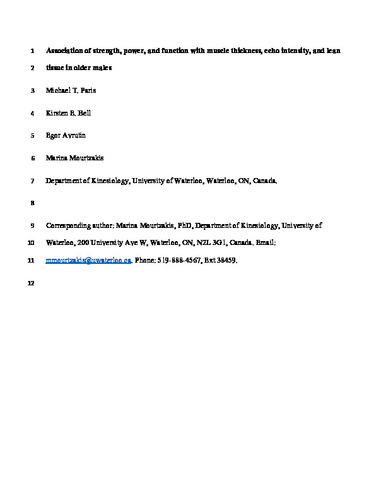| dc.contributor.author | Paris, Michael | |
| dc.contributor.author | Bell, Kirsten Elizabeth | |
| dc.contributor.author | Avrutin, Egor | |
| dc.contributor.author | Mourtzakis, Marina | |
| dc.date.accessioned | 2023-05-10 15:36:47 (GMT) | |
| dc.date.available | 2023-05-10 15:36:47 (GMT) | |
| dc.date.issued | 2022-05 | |
| dc.identifier.uri | https://doi.org/10.1139/apnm-2021-0690 | |
| dc.identifier.uri | http://hdl.handle.net/10012/19438 | |
| dc.description | This is the Accepted Manuscript version of the paper; the version of record is published by Applied Physiology, Nutrition, and Metabolism and can be found here: https://doi.org/10.1139/apnm-2021-0690 | en |
| dc.description.abstract | Dual-energy X-ray absorptiometry (DXA) appendicular lean tissue is used to screen older adults for sarcopenia. However, emerging data indicates that ageing-related muscle atrophy largely occurs within specific muscles, which may be masked using appendicular lean tissue. Comparisons between appendicular lean tissue and site-specific measures of muscle in relation to strength and physical function are needed to advance our understanding of these features in the context of poor muscle function in aged adults. Our primary objective was to compare correlations between lean tissue and sitespecific muscle characteristics in relation to strength and physical function in older males. Older males (≥65 years) were
evaluated for muscle strength, physical function (6-minute walk and 30-second sit-to-stand), and muscle size (appendicular and site-specific) and composition (echo intensity) using DXA and ultrasound. Of the 32 older males (75.467.9 years), 12 had low appendicular lean tissue. All DXA and ultrasound muscle characteristics were associated (r = 0.39 to 0.83, p < 0.05) with torque or power producing capabilities. Except for the knee flexors, no differences in correlation coefficients were observed between muscle thickness or regional lean tissue in relation to muscle strength. Neither DXA nor ultrasound muscle characteristics were associated with physical function. In older males, ultrasound-based muscle thickness and DXA lean tissue provided similar associations with strength. | en |
| dc.language.iso | en | en |
| dc.publisher | Canadian Science Publishing | en |
| dc.relation.ispartofseries | Applied Physiology Nutrition and Metabolism; | |
| dc.subject | ultrasound | en |
| dc.subject | body composition | en |
| dc.subject | dual energy X-ray absorptiometry | en |
| dc.subject | aging | en |
| dc.subject | skeletal muscle | en |
| dc.subject | strength | en |
| dc.title | Association of strength, power, and physical performance with muscle mass and composition in older males: a comparison of muscle thickness, echo intensity, and lean tissue mass | en |
| dc.type | Article | en |
| dcterms.bibliographicCitation | Paris, M. T., Bell, K. E., Avrutin, E., & Mourtzakis, M. (2022). Association of Strength, power, and function with muscle thickness, echo intensity, and lean tissue in older males. Applied Physiology, Nutrition, and Metabolism, 47(5), 521–528. https://doi.org/10.1139/apnm-2021-0690 | en |
| uws.contributor.affiliation1 | Faculty of Health | en |
| uws.contributor.affiliation2 | Kinesiology and Health Sciences | en |
| uws.typeOfResource | Text | en |
| uws.peerReviewStatus | Reviewed | en |
| uws.scholarLevel | Faculty | en |

